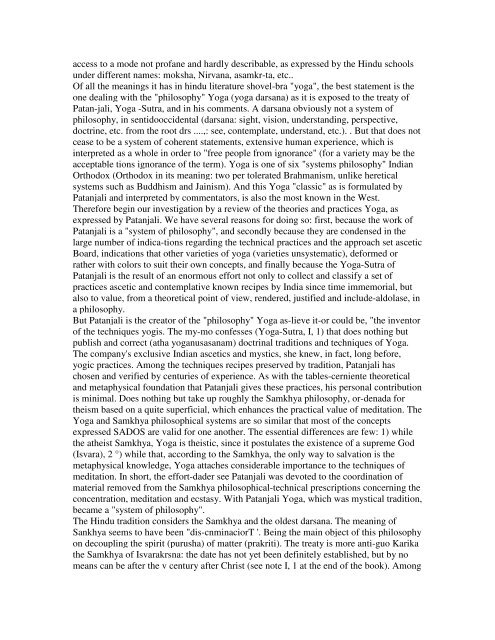Mircea Eliade YOGA IMMORTALITY AND ... - Brihaspati.net
Mircea Eliade YOGA IMMORTALITY AND ... - Brihaspati.net
Mircea Eliade YOGA IMMORTALITY AND ... - Brihaspati.net
You also want an ePaper? Increase the reach of your titles
YUMPU automatically turns print PDFs into web optimized ePapers that Google loves.
access to a mode not profane and hardly describable, as expressed by the Hindu schools<br />
under different names: moksha, Nirvana, asamkr-ta, etc..<br />
Of all the meanings it has in hindu literature shovel-bra "yoga", the best statement is the<br />
one dealing with the "philosophy" Yoga (yoga darsana) as it is exposed to the treaty of<br />
Patan-jali, Yoga -Sutra, and in his comments. A darsana obviously not a system of<br />
philosophy, in sentidooccidental (darsana: sight, vision, understanding, perspective,<br />
doctrine, etc. from the root drs ....,: see, contemplate, understand, etc.). . But that does not<br />
cease to be a system of coherent statements, extensive human experience, which is<br />
interpreted as a whole in order to "free people from ignorance" (for a variety may be the<br />
acceptable tions ignorance of the term). Yoga is one of six "systems philosophy" Indian<br />
Orthodox (Orthodox in its meaning: two per tolerated Brahmanism, unlike heretical<br />
systems such as Buddhism and Jainism). And this Yoga "classic" as is formulated by<br />
Patanjali and interpreted by commentators, is also the most known in the West.<br />
Therefore begin our investigation by a review of the theories and practices Yoga, as<br />
expressed by Patanjali. We have several reasons for doing so: first, because the work of<br />
Patanjali is a "system of philosophy", and secondly because they are condensed in the<br />
large number of indica-tions regarding the technical practices and the approach set ascetic<br />
Board, indications that other varieties of yoga (varieties unsystematic), deformed or<br />
rather with colors to suit their own concepts, and finally because the Yoga-Sutra of<br />
Patanjali is the result of an enormous effort not only to collect and classify a set of<br />
practices ascetic and contemplative known recipes by India since time immemorial, but<br />
also to value, from a theoretical point of view, rendered, justified and include-aldolase, in<br />
a philosophy.<br />
But Patanjali is the creator of the "philosophy" Yoga as-lieve it-or could be, "the inventor<br />
of the techniques yogis. The my-mo confesses (Yoga-Sutra, I, 1) that does nothing but<br />
publish and correct (atha yoganusasanam) doctrinal traditions and techniques of Yoga.<br />
The company's exclusive Indian ascetics and mystics, she knew, in fact, long before,<br />
yogic practices. Among the techniques recipes preserved by tradition, Patanjali has<br />
chosen and verified by centuries of experience. As with the tables-cerniente theoretical<br />
and metaphysical foundation that Patanjali gives these practices, his personal contribution<br />
is minimal. Does nothing but take up roughly the Samkhya philosophy, or-denada for<br />
theism based on a quite superficial, which enhances the practical value of meditation. The<br />
Yoga and Samkhya philosophical systems are so similar that most of the concepts<br />
expressed SADOS are valid for one another. The essential differences are few: 1) while<br />
the atheist Samkhya, Yoga is theistic, since it postulates the existence of a supreme God<br />
(Isvara), 2 °) while that, according to the Samkhya, the only way to salvation is the<br />
metaphysical knowledge, Yoga attaches considerable importance to the techniques of<br />
meditation. In short, the effort-dader see Patanjali was devoted to the coordination of<br />
material removed from the Samkhya philosophical-technical prescriptions concerning the<br />
concentration, meditation and ecstasy. With Patanjali Yoga, which was mystical tradition,<br />
became a "system of philosophy".<br />
The Hindu tradition considers the Samkhya and the oldest darsana. The meaning of<br />
Sankhya seems to have been "dis-cnminaciorT '. Being the main object of this philosophy<br />
on decoupling the spirit (purusha) of matter (prakriti). The treaty is more anti-guo Karika<br />
the Samkhya of Isvarakrsna: the date has not yet been definitely established, but by no<br />
means can be after the v century after Christ (see note I, 1 at the end of the book). Among







